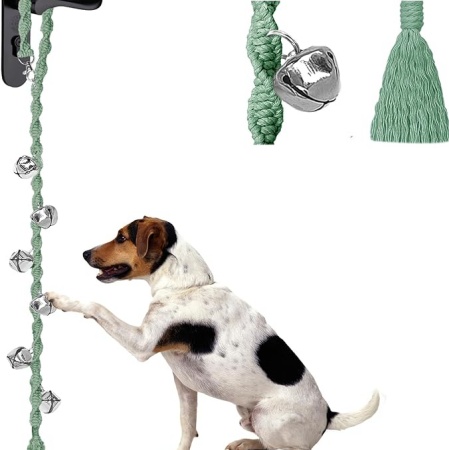
Best Doggie Doorbell:15+ Models Tested for Potty Training
Are you training your doggie doorbell manners, or does your furry friend incessantly scratch or bark at the door to go outside? You need a

Wondering what’s so fantastic about bell train a dog? Picture a world where your furry friend always alerts you when they need to go outside, eliminating accidents indoors.
To achieve this, it’s crucial to understand that your puppy won’t instinctively know how to potty outside; you must teach them. Establishing clear guidelines and communication is the first step in guiding them in the right direction.
While some puppies may offer subtle signs like sniffing or circling before relieving themselves, these signals demand constant vigilance.
As your pup grows and gains more independence, having a reliable and audible signal, like potty training bells, becomes invaluable. Combine this with crate training and techniques to prevent excited puppy accidents, and you’ll be on the path to successful in-home puppy training and much more.
Bell training for dogs is a useful housetraining method, akin to a doorbell, that teaches your puppy to ring a bell to signal when they need to go outside for potty breaks.
There are various types of bell training tools available, including:
The service desk or courtesy bell is designed to be placed on the floor near the door, allowing your puppy to easily tap it with their paw when it’s time for a bathroom break.

Hanging dog bells offer great convenience as they can be hung from virtually any door handle and can be adjusted to accommodate your growing puppy.
Featuring multiple bells suspended from a sturdy strap, these potty training bells are both durable and easy for puppies to learn to use. They also ensure that you can hear them clearly, even when you’re in another room.

While wall-mounted housetraining bells may appear stylish, they tend to be less practical. This type of potty bell requires attachment to a wall using screws and needs constant adjustment to the right height as your puppy grows. This can result in wall damage and inconvenience as your puppy ages and changes in size.

As your puppy grows and its ability to move and reach evolves, it’s crucial to have a potty bell that is not only robust and user-friendly but also adjustable. For these reasons, I suggest opting for Adjustable Hanging Potty Bells or Courtesy Desk Potty Bells. These options ensure durability, ease of use, and the flexibility to adapt as your puppy matures.
Step 1
Position the adjustable potty bells close to or beside the door you wish your puppy to use for restroom outings.
Step 2
Set the strap length so the lower bells are just off the ground and within easy reach for your pup.
Step 3
Instruct your puppy on how to signal with the potty bells whenever she needs to go outside for a bathroom break.
PRO TIP: Place the potty bells near the door rather than on the doorknob. This way, the bells will only sound when your puppy specifically needs to go out potty. If they are on the doorknob, the bells will chime each time the door is used, potentially confusing your puppy about their purpose for indicating potty time.
Step 1
Set the dog doorbell on the ground near the door you’re training your puppy to use for outdoor bathroom trips. Position the potty bell in a spot where it won’t be hit by the door as it opens, to avoid unintentional ringing when the door is used.
Step 2
Guide your puppy in learning how to press the dog doorbell to signal you when it’s time for a potty break outside.
Training your puppy with potty bells is a straightforward process, divided into three easy steps. Get your potty bells ready!
Purchase a set of potty training bells that are audible enough for you when your dog uses them. Install the potty training bells at your dog’s height on the wall beside the primary “potty door.”
Before heading outside, ring the potty bells yourself while saying, “Go Potty.” Lead your puppy out on a leash consistently to the same spot each time.
After your puppy finishes its business, repeat “Go Potty” and reward your dog with a treat. Continue this method each time your puppy goes outside for approximately a week.
The next phase involves encouraging your puppy to ring the potty bell independently.
Begin by showing your puppy a treat before going out. Gradually move the treat towards the potty training bells, enticing your dog to follow the treat to the bells. When your puppy’s nose or paw makes contact with the potty bells, say, “Let’s Go Potty Outside,” and escort your puppy to the “potty area.”
Once your puppy is done, say “Go Potty” again and give the treat. It’s crucial to reward your puppy for using the bathroom outside, which is why the treat is given only after completing the task outside! This step may take about a week, possibly varying by a few days depending on your puppy.
With your puppy now actively using the potty training bells, begin to wean off the treat lure. Just before taking your puppy outside, gesture towards the potty bells with an empty hand, instead of leading with a treat.
When your puppy rings the potty training bells, say, “Go Potty,” and guide him to the “potty spot.” After your pup finishes, repeat “Go Potty” and reward with a treat.
Always use a leash during potty training. This helps your pup understand that the potty training bells signify “Go Potty” and not just an opportunity to play outside.
If your puppy doesn’t go potty, briefly confine her inside (either on a leash or in her crate) for 5 to 10 minutes and then repeat the bell training steps.
Patience is key to your puppy and yourself. Consistency and fairness will ensure both you and your pup master this training in no time!
Typically, puppies need to relieve themselves at least every 2 to 4 hours. Younger puppies require more frequent outings as they are still developing bladder control.
The American Kennel Club (AKC) suggests a “month-plus-one” guideline to establish a suitable potty routine for your puppy. Calculate the time interval by adding one to your puppy’s age in months. This gives you the maximum hours your puppy can comfortably wait before needing to go potty.
For instance, a 2-month-old puppy should be taken out at least every 3 hours once he’s accustomed to bladder control through effective dog potty training.
However, like most rules, there are exceptions. Your puppy’s potty needs may vary.
Additionally, your puppy will likely need to go potty within 30 minutes after eating, right after waking up from a nap, following playtime, or after any significant physical activity.
Although bell training is an effective tool, it’s equally important to understand and recognize the natural behavioral signals your dog may display when they need to use the bathroom. These signals can include:
In conclusion, bell train a dog offers a structured and efficient method for potty training your puppy. By understanding and implementing the steps outlined – from choosing the right type of bell to guiding your puppy through the process – you create a clear communication channel for your pet’s potty needs.
Remember, it’s not just about the bells; recognizing your dog’s natural behavioral signals is equally crucial. This comprehensive approach, encompassing both bell training and behavioral awareness, will lead to a well-trained puppy and a cleaner, happier home environment.
So, when considering potty training, think of bell training a dog as your go-to strategy for success.
If you’re interested in the topic of this post but are tired of reading text, you can watch the video we’ve selected for you below:
FAQ: How Long Does It Take to Successfully Bell Train a Dog?
Answer: The duration of bell training varies depending on the individual dog’s learning speed and consistency of training. On average, it can take a few weeks to a couple of months. Regular practice and positive reinforcement are key factors in determining the training duration.
FAQ: Can Older Dogs Be Trained to Use Potty Bells, or Is It Only for Puppies?
Answer: Absolutely! Older dogs can be trained to use potty bells. The training process might require additional patience and consistency, but dogs of any age can learn to use bells for potty signals.
FAQ: Are There Specific Breeds That Respond Better to Bell Training?
Answer: Bell training is not breed-specific; it can be effective for any breed. The success of bell training depends more on the individual dog’s temperament and the owner’s consistency in training rather than the breed of the dog.
FAQ: How Do I Prevent My Dog from Ringing the Bells Just to Go Outside for Play?
Answer: To prevent this, only respond to bell rings with a bathroom break and not playtime. This helps your dog associate the bell with potty breaks only. If they ring the bell and don’t go potty, bring them back inside immediately to reinforce this association.
FAQ: If I Have Multiple Dogs, Should I Train Them Separately on the Potty Bells?
Answer: Training dogs separately can be beneficial, especially in the beginning, to avoid confusion and ensure each dog understands the concept individually. However, dogs often learn from observing each other, so joint training sessions can also be effective once each dog has grasped the basics.


Are you training your doggie doorbell manners, or does your furry friend incessantly scratch or bark at the door to go outside? You need a

When it comes to dog pee, much like humans, the urine of animals is a vital health indicator. Just as human urine reveals a lot

Noticed your dog yawn more often than usual? While it’s adorable, it could also be a sign of something to consider if it appears excessive.

A potty doorbell is essentially a bell placed near your entrance that your dog can ring to indicate her need to go potty. No matter

Are you training your doggie doorbell manners, or does your furry friend incessantly scratch or bark at the door to go outside? You need a

When it comes to dog pee, much like humans, the urine of animals is a vital health indicator. Just as human urine reveals a lot

Noticed your dog yawn more often than usual? While it’s adorable, it could also be a sign of something to consider if it appears excessive.

Wondering what’s so fantastic about bell train a dog? Picture a world where your furry friend always alerts you when they need to go outside,
Copyright © 2024 doggydogdoorbell. All Rights Reserved.